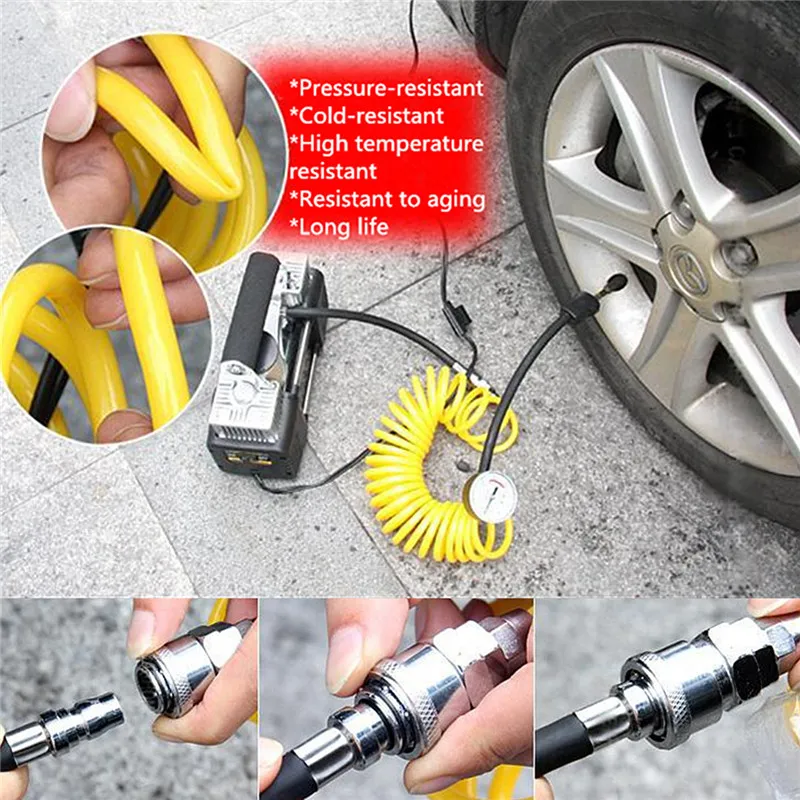It is essential to keep your tires adequately filled with air. Underinflated tires can suffer from overheating, uneven wear and less efficiency. However, it can sometimes be inconvenient to take your flat tires to a professional. In that case, it is helpful to know how to fill a tire using an air compressor on your own.
The first step is to make sure you have the correct tools for the job. Otherwise, you won’t be able to safely and effectively fill your tire to the proper specifications. You will need several tools, including:
The two most common types of tires you can fill at home with an air compressor are car and bike tires. You can also use an air compressor to fill the tires of dirt bikes, lawnmowers, tractors and other equipment. Here are the basic steps for filling tires with an air compressor:

While the basic method of filling tires is the same, knowing how to fill a bike tire with an air compressor is slightly different from a car tire. There are several variations, including:
Understanding these differences is vital in knowing how to service your bike tire with an air compressor.
Air compressors can help refill tires on cars, bikes and other equipment. There are some differences across each tire type, but the process is mostly the same. With Quincy Compressor, you can find the perfect air compressor to fill up any of your flat tires on your own. Contact us today for more information, or explore our portable air compressor options!
There are some differences across each tire type, but the process is mostly the same. With Quincy Compressor, you can find the perfect air compressor to fill up any of your flat tires on your own. Contact us today for more information, or explore our portable air compressor options!
You never know when you may experience a flat tire. It can happen to anyone at the most inconvenient time. Maintaining correct tire pressure affects a tire’s wear and improves its performance. Luckily, you can easily inflate almost any tire at your job site if you have an air compressor. Read on to learn how to use an air compressor on your flat tire.
You need to know how much air pressure must go into the tire. Most construction vehicles need at least 100 pounds per square inch, or PSI, in each tire. The exact amount might vary depending upon the axle load, number of tires per axle, and weather. Check the vehicle’s owner’s manual for the proper tire pressure amount.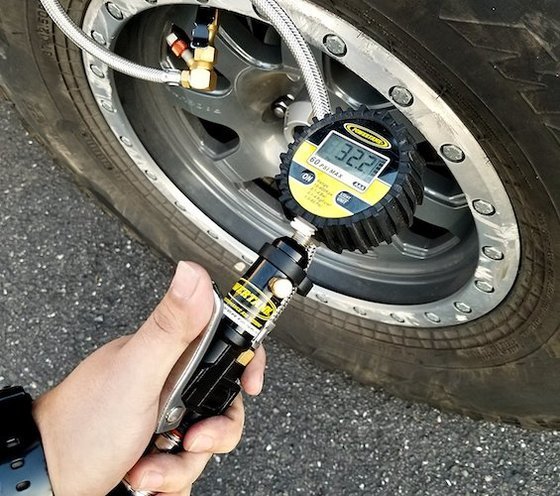
Avoid using the PSI number found on the tire’s sidewall since that expresses the maximum amount of pressure. You need this information to know what type of air compressor to get. A smaller air compressor tank keeps the pressure between 100 to 150 PSI.
A tire gauge can tell you how much compressed air your tires need to have added. If you put too much air into tires, you can experience performance and handling issues. If you don’t put enough air into the tires, they can experience extra friction that raises the rubber’s temperature. Heat is harmful to tires and can cause damage to the steel cords inside. Many tire manufacturers state that for every 3 PSI below the recommendation, you burn 1 percent more fuel and add 10 percent extra tire wear.
When filling up the tires, try to do so when they’re cold. Cold temperatures can give you a more accurate reading. Hot tires show higher air pressure when you use the tire gauge. If you get a flat tire while driving, wait about 30 minutes for the tire to cool. If this is not an option, inflate the tires to 3 PSI over the recommended amount.
If this is not an option, inflate the tires to 3 PSI over the recommended amount.
Each tire should have a stem cap screwed to the top of the valve stem. Remove the cap and put it to the side, but make sure you don’t misplace it. When the cap is off the valve, even if it’s just for a minute, some of the leftover air could escape. Avoid removing the cap until you’re ready to use the compressor.
Typical air compressors run on electrical power. Plug in the air compressor to let it accumulate with air. Smaller units have a two-prong plug, while medium and larger compressors may need a three-prong plug. Make sure you’re using outlets with the correct voltage for the compressor. Running the compressor on the wrong circuit can blow the compressor, circuit, or both. Once you turn on the compressor, you will hear the compressor motor begin to work. Portable units have tires, so you can easily move them around.
Try to situate the compressor near the flat tire since you cannot move the vehicle.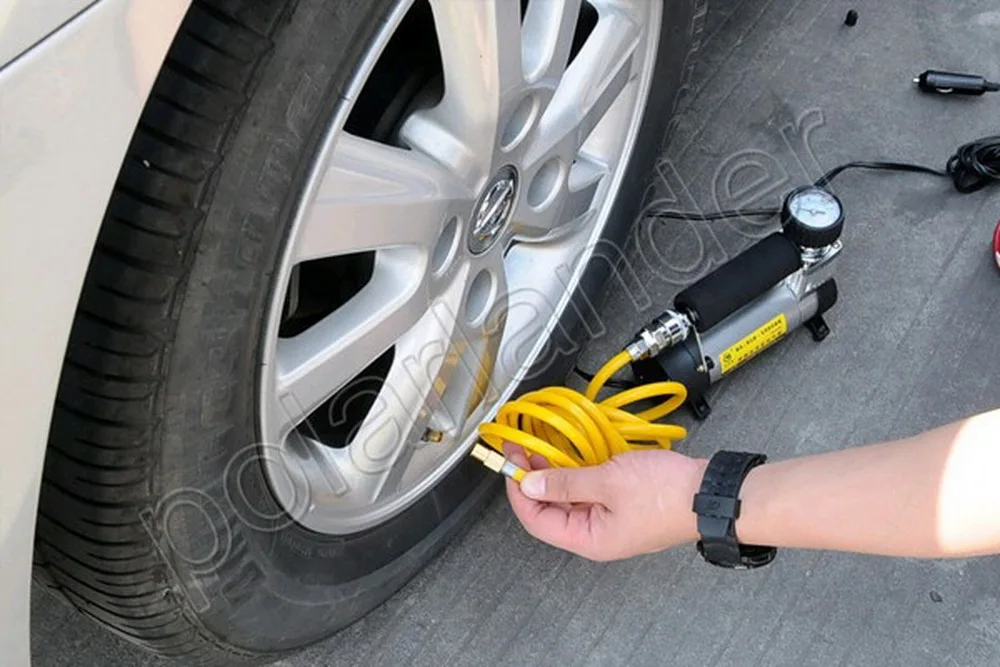 Attach the air hose to the compressor and include the quick coupler at the end. This fastener lets you push air into the valve stem. If there’s a safety position on the nozzle, make sure that you activate it. Secure the hose to the valve stem and turn on the machine.
Attach the air hose to the compressor and include the quick coupler at the end. This fastener lets you push air into the valve stem. If there’s a safety position on the nozzle, make sure that you activate it. Secure the hose to the valve stem and turn on the machine.
Depending upon how flat the tire is, filling the tire up with air may take some time. Many air compressors have gauges that guide you, so you add the correct amount of air. Some inflators even turn off automatically when the desired air pressure is reached. Digital inflators are another option, and they give you a more accurate reading. Avoid walking away from the compressor while it is running, as you don’t want the tires to overinflate.
While filing up the tire, check the tire pressure occasionally. Most digital inflators automatically monitor the pressure and shut off when the desired pressure is reached. If you accidentally add too much air, push down on the tire gauge to release some of the air. When you have the right amount of air, remove the hose from the compressor. You might hear a hissing noise when you remove this piece. Don’t worry as this is perfectly normal. Put the stem cap back on the valve.
When you have the right amount of air, remove the hose from the compressor. You might hear a hissing noise when you remove this piece. Don’t worry as this is perfectly normal. Put the stem cap back on the valve.
If you are unlucky enough to experience a flat tire, don’t worry. You can easily use an air compressor and a few simple tools to inflate the flat tire. By following a few simple tips, you can get back on the road in no time.
All pressure gauges built into the compressors show incorrect values! And the reason is not only the inaccuracy of the instruments.
The examination of compressors with digital pressure gauges did not involve big "discoveries". However, at the very first measurements, an interesting thing turned out: the reference pressure gauge showed that the pressure in the inflated tire was not at all the same as that set for the compressor.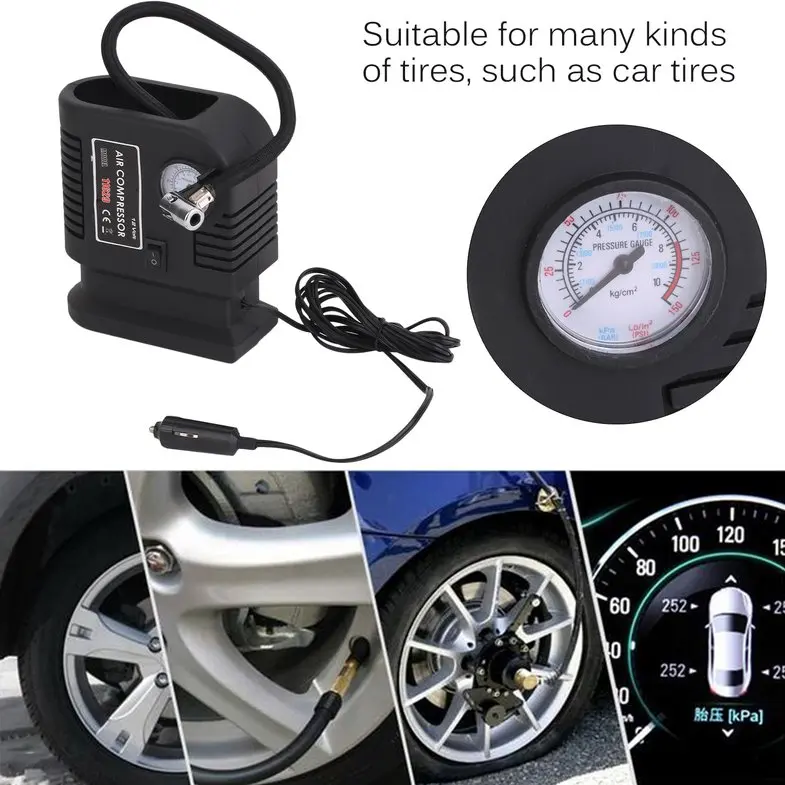 They took another compressor - the tire again turned out to be under-inflated. And so it was repeated with all the devices. Why?
They took another compressor - the tire again turned out to be under-inflated. And so it was repeated with all the devices. Why?
Related materials
10 pumps: Compressor expertiseTire pressure monitoring systems - how they workTire pressure: your norm
First thought: regular pressure gauges lie. To check them, a splitter was connected to the compressor hose. One of its sleeves was connected to an exemplary pressure gauge, and the other to the inflated wheel.
Related materials
How to inflate a tire without a pump? 5 myths and 2 risky ways
Indeed, they all lied, but at the same time, the pressure in the inflated tire still did not correspond to the required one. An exemplary pressure gauge connected to a running compressor showed 2.0 bar, but as soon as the electric motor died, the pressure decreased to 1.8 bar. The same exemplary pressure gauge showed when connected directly to the wheel valve. How to explain this fact?
How to explain this fact?
The fact is that approximately 0.2 bar is lost when overcoming a narrow bottle neck - channels in the spool. As soon as the compressor turns off and the air flow becomes equal to zero, the pressure in the entire system immediately equalizes - then the error of the compressor pressure gauge can be estimated.
Related materials
Pump up or inflate? Non-Standard Compressor Test
Understanding came when they guessed to connect a valve turned out of the wheel to a running compressor. It would seem that the pressure gauge should show zero: after all, there is no back pressure. However, the very first experience showed an excess of 0.4 bar! Having gone through several valves from different manufacturers, we determined the range of "overestimations" - from 0.4 to 0.6 bar.
The variation in readings depends on how much the valve stem moves when the compressor hose nozzle presses on it . Just don’t think that we didn’t fit or screw the pump tip onto the valve tightly enough. If the tip does not press the spool pin at all, then the valve will open at a pressure of at least 5 bar. And such an ordinary automobile compressor develops with great difficulty.
If the tip does not press the spool pin at all, then the valve will open at a pressure of at least 5 bar. And such an ordinary automobile compressor develops with great difficulty.
Scheme of installation for checking pressure gauges of compressors
1 - wheel, 2 - valve, 3 - exemplary pressure gauge, 4 - tested compressor with built-in pressure gauge.
This "error" is easiest to catch when you inflate a completely flat tire. The pressure gauge in the first second of compressor operation will show a pressure of at least 0.4 bar. This is the backwater formed by very narrow sections for the passage of air in the spool. And its value is maximum on a flat tire. Why does it decrease as the tire pressure increases?
Related materials
Small-sized tire compressors: expertise of the magazine "Behind the wheel"
At the beginning of pumping, the flow is maximum, the speed is high and the resistance (it is proportional to the square of the speed) is greater.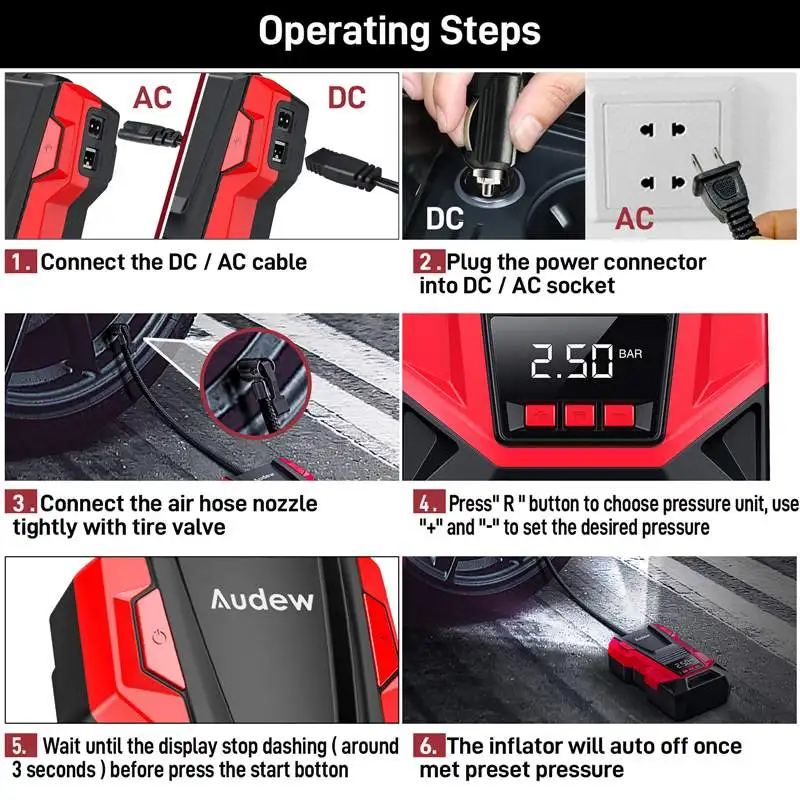 As the tire is inflated, it becomes harder for the compressor to pump, the air consumption drops, and with it, the resistance on the spool decreases. Therefore, at high pressures, compressor pressure gauges show tire pressure more and more accurately. And at the maximum pressure that the pump can develop, the flow rate, and with it the back pressure, tends to zero. And the measurement error disappears.
As the tire is inflated, it becomes harder for the compressor to pump, the air consumption drops, and with it, the resistance on the spool decreases. Therefore, at high pressures, compressor pressure gauges show tire pressure more and more accurately. And at the maximum pressure that the pump can develop, the flow rate, and with it the back pressure, tends to zero. And the measurement error disappears.
The connecting element, slipped or screwed onto the valve, also plays a role in the resistance of the air supply line from the compressor to the tire. The largest air passage is provided by tap type tips, and the greatest resistance - up to 0.15 bar - is provided by tips with a narrow gap. But it is especially important that the tip fully presses the spool valve. Because if it does not fully open, the resistance of the spool will become even greater. The correct connection of the tip to the valve is important here. It is necessary to ensure the tightest possible putting on (or screwing) of the tip.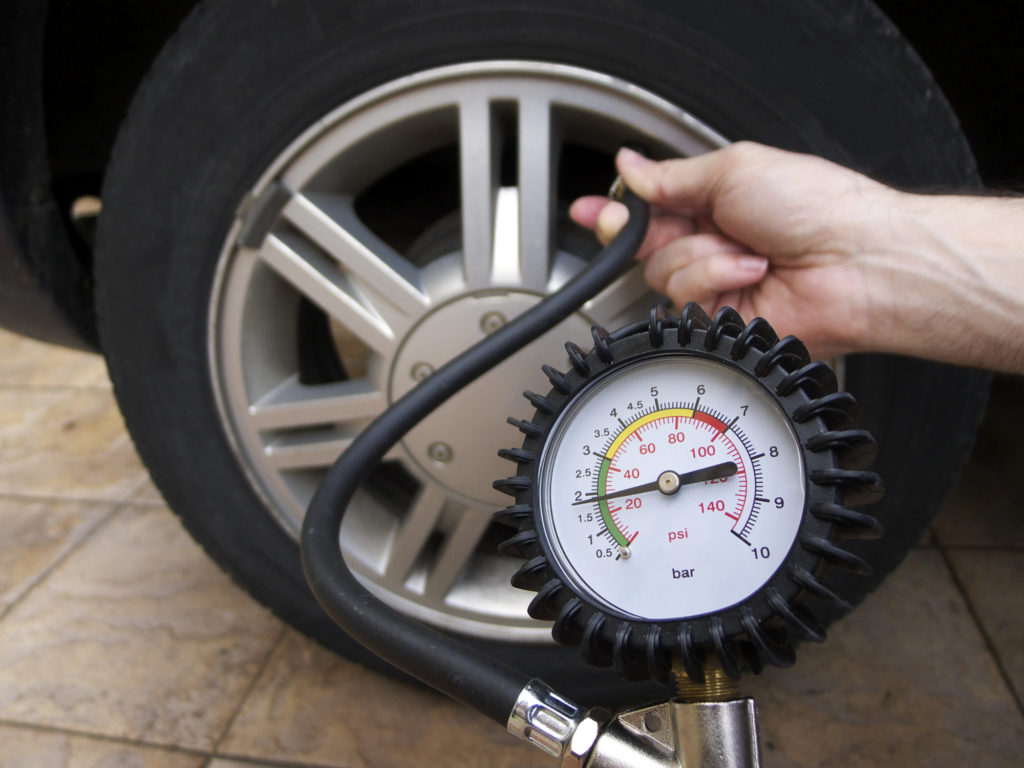
Compressor tips are available in different designs. The larger the cross section, the better for the passage of air.
Compressor tips are available in different designs. The larger the cross section, the better for the passage of air.
It remains to recognize the obvious: it is impossible to accurately set the pressure using compressor pressure gauges . After all, any valve is an obstacle to the air flow. And any obstacle creates the same counterpressure. For this reason, in all compressors, the generated pressure always exceeds that which we later measure directly on the wheel. Therefore, even the most accurate built-in device will always show a pressure higher than in the tire. And accordingly, the compressor will turn off earlier than necessary.
It is better to inflate the wheel with a margin, measure the pressure with an accurate pressure gauge and bring it back to normal by bleeding excess air from the tire.
Related materials
Choosing a tire pressure gauge - cheaper and more accurate
You can set the pressure with some advance. If you need to get 2.0 bar, you should inflate the wheel to 2.2 bar. However, different valves create different back pressure, the value of which is not known in advance. And even in one car, she can walk from wheel to wheel. We encountered this phenomenon in the examination of electronic pressure gauges (we will publish it in the September issue of the journal). By the way, in most cases their accuracy is higher than that of devices built into compressors. Therefore, we advise everyone to get such a pressure gauge in addition to the compressor.
As a result of , the surest way is to inflate the wheel to a known higher pressure, with an excess of 0.2–0.3 bar, and then measure the actual pressure with a pressure gauge, bleeding air from the tire if necessary .
OUR REFERENCE
Spool design
2 - seal; 3 - threaded bushing; 4 - spool rod; 5 - valve body; 6 — valve body; 7 - conical spring; 8 - valve cup. The spools of the old (a) and new (b) samples are completely interchangeable. The air resistance is about the same.
The spools of the old (a) and new (b) samples are completely interchangeable. The air resistance is about the same.
If you looked into the wheel valve hole, you probably saw a spool there. This device, standardized throughout the world, is used not only in the wheels of cars, motorcycles and bicycles, but also in air conditioners, scuba gear and other elements of pneumatic equipment.
It is the Schrader valve that creates the main resistance to the air flow. Due to its influence, no pressure gauge will show the correct pressure while the compressor is inflating the wheel.
/ Rules.
Summer tires at low prices - delivery, tire fitting.
The problem of depressurization of pneumatic tires has not yet been solved. Therefore, the question of how to pump up a car wheel with a compressor remains relevant. It's always annoying to find your car with a flat tire. We must hurry on business, and then there is this misfortune. Regular use of the electric pump makes the driver trained. But the rare use of a compressor, or a complete lack of experience, can puzzle the car owner.
Therefore, the question of how to pump up a car wheel with a compressor remains relevant. It's always annoying to find your car with a flat tire. We must hurry on business, and then there is this misfortune. Regular use of the electric pump makes the driver trained. But the rare use of a compressor, or a complete lack of experience, can puzzle the car owner.
The car tire inflation compressor is an electric motor with a piston and a cylinder. To supply power to the electric pump motor, a long wire with a plug is used. The design of the plug is designed for quick connection to the cigarette lighter socket. Simply plug into the cigarette lighter and then press the toggle switch on the compressor. Everything should work.
What if the cigarette lighter does not work? A new nuisance appears due to a blown fuse. You can open the fuse box and check the elements for the integrity of the threads. If the reason turned out to be this, then this is easily fixed by installing a new fuse.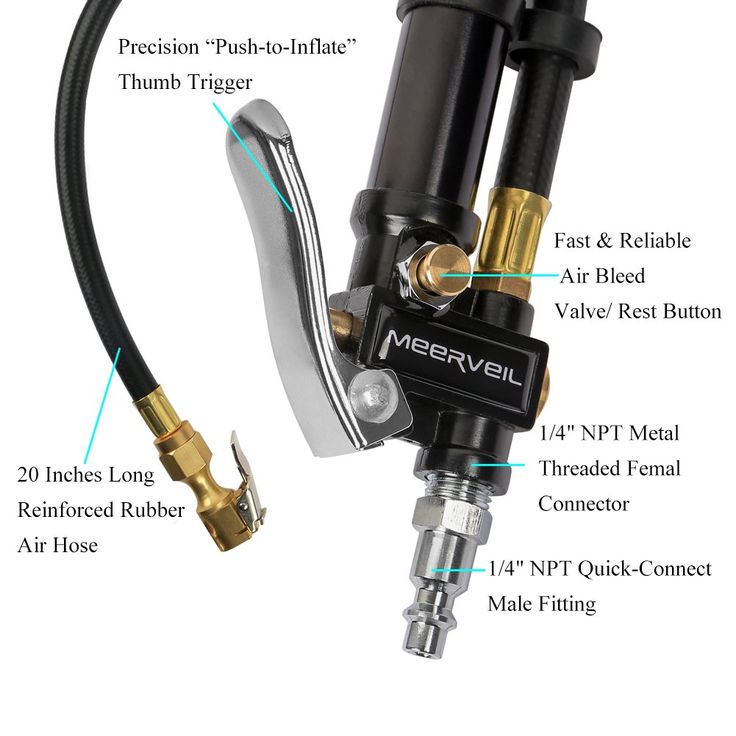
The cigarette lighter continues to refuse to work, and there is no time to search for the causes of the problem. You will have to connect the compressor directly to the battery. To do this, cut the plug from the cable. Next, strip the ends of the wires so that the strand can be looped around your finger. These will be the clamps. We dress improvised terminals on the battery (red wire "+", black "-"). We turn on the compressor. If the battery is old, it is recommended to pump the wheels with the engine running. In the future, after repairing the cigarette lighter, the cut off plug must be connected to the cable, and the wire twists must be insulated.
If there is a compressor, but no experience with tire inflation, then an exercise should be carried out. To do this, it is enough to know the rules that will help you act in a certain sequence:

Pump hose end with lock. In the vertical position, the valve is closed and the tip is ready to be fitted onto the wheel fitting. After moving the lever to a horizontal position, the tip is fixed on the fitting, opening the nipple for air supply.
Each vehicle is designed to use a specific tire size. In addition, tires must have working pressure. To inform the car owner about the type of tires and the air rate, the automaker sticks an information label in the driver's doorway. Sometimes, a decal is placed in the passenger doorway. The content is arranged in the form of a table, which will indicate different pressures in the wheels for winter and summer operation.
Don't wait for the air to completely leak from the tires. It is recommended to check the sufficiency of tire pressure every two weeks. This will reduce rubber wear, since even minus 0.5 atm. reduces the life of tires, especially the side profile. In addition, weak tires lead to an increase in fuel consumption, as they are less resistant to rolling resistance. Along with this, under-inflated tires are prone to the formation of hernias. And yet, a weak wheel harms the suspension, not to mention the deterioration of the car's directional stability on the track.
In addition, weak tires lead to an increase in fuel consumption, as they are less resistant to rolling resistance. Along with this, under-inflated tires are prone to the formation of hernias. And yet, a weak wheel harms the suspension, not to mention the deterioration of the car's directional stability on the track.
Train yourself to look after the condition of your tyres. A simple operation to inspect the wheels and measure the pressure with a pressure gauge can delay the purchase of new wheels for a couple of seasons. And this is a significant savings in the personal budget.
The Complete Guide to Portable Air Compressors for Inflating Tires
Portable air compressors are used for many purposes and depending on the size they can perform all kinds of different tasks. One of the most common uses for a portable air compressor is tire inflation, and there are many units designed specifically for this purpose. But whether you need to clean up sawdust after a renovation or add a coat of paint to a closet, these handy and versatile tools can get the job done quickly and easily.
Many homeowners believe that owning a portable air compressor is one of the best tool investments, and anyone who has ever owned one will agree that an air compressor shouldn't be in the garage, even if it's just an air pump tires. You will find a lot of articles on our site about large portable air compressors, but this article will focus on a small set designed to keep your tires properly inflated.
An air compressor is simply a tool that draws air into its reservoir and stores the air until there is enough pressure to release it with much more power. If you want a complete understanding of how an air compressor works compressor, we recommend that you read this article.
Air compressors come in all sizes and many are small enough to be carried in a car or truck or even stored in a car. Others are larger and less portable, but tend to be more powerful. Therefore, finding the right air compressor will require a good understanding of your requirements, as well as the power and dimensions of the air compressor.
Having an air compressor at home can be a huge benefit. It can help you complete many different basic home repairs. You can clean electronics, inflate car and bike tires, clean sawdust and other debris, use them for crafts, and even paint your house!
Many professionals own several air compressors. Some are large with lots of power, while others are much smaller and can be easily moved from one job to another.
More powerful compressors allow you to take on woodworking projects or other more complex home improvement tasks. However, small air compressors are great for light duty work when you don't want to pack a large unit to the job site.
A common misconception is that an air compressor is designed for either industrial applications or tire inflation. A lot of people just don't realize how versatile they are. Finding the right size unit plays a big role in what you can do with your compressor. Here are just a few of the many possible uses for it:
Here are just a few of the many possible uses for it:
tire inflation - Using an air compressor to inflate tires not only gives you more power, but you even have the ability to lift air. tires that have become non-beaded. A good portable air compressor is suitable not only for car tires, but also for motorcycle and bicycle tires. The next time a tire rolls onto a hand truck or cart, you won't have to worry about driving to the gas station. You can just feed it to the compressor and fill it up in no time!
Paint Sprayers - Using an air compressor with a paint sprayer not only increases the power of the paint sprayer, but also ensures even coverage with no signs of paint bleeding. Almost all automotive paint shops use a pressurized paint sprayer. Read our Air Compressor Painting Guide to find out which air compressors we recommend.
Power tools - Just because you bought a portable air compressor for tire inflation doesn't mean you can't use it for anything else.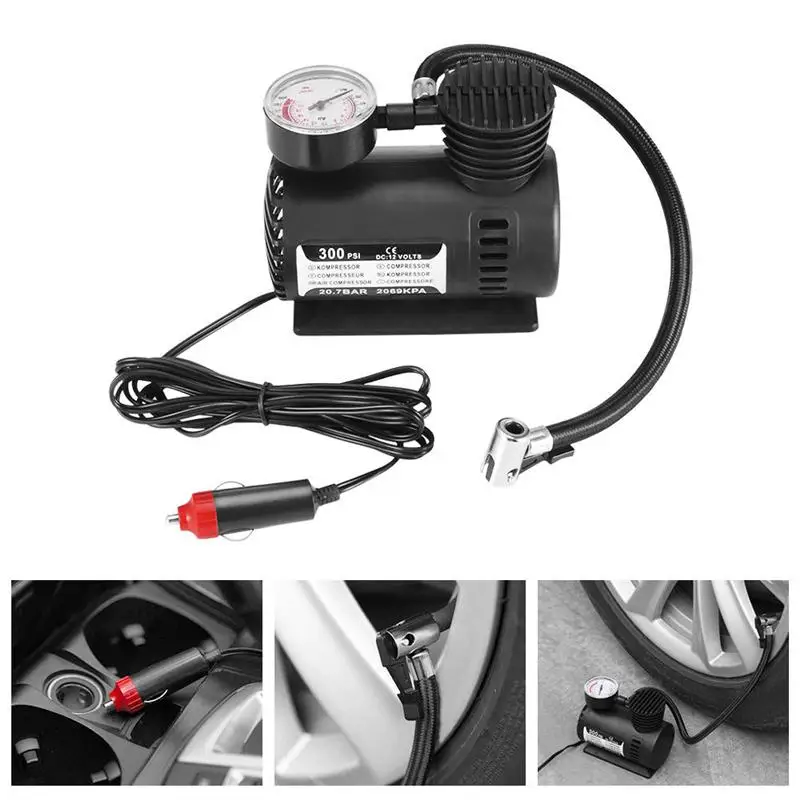 Air compressors work great with power tools in your home. Some of the more popular tools include: nail guns, drills, grinders, wrenches and ratchets.
Air compressors work great with power tools in your home. Some of the more popular tools include: nail guns, drills, grinders, wrenches and ratchets.
Using a power tool with compressed air increases the power of the tool, which is one of the main advantages of using a compressor. All this makes pneumatic tools more efficient than those that are not with air compressor.
multipurpose - The compressed air from your portable air compressor can be used for many household applications. With the right air nozzle, air can be used anywhere; from woodworking projects to pool plumbing cleaning and cleaning.
Portability - We're going to state the obvious here. The portable air compressor is portable. It can fit almost anywhere. You can take it with you in your car, use it in the garage, or just lend it to a friend.
According to the latest government research on fueleconomy.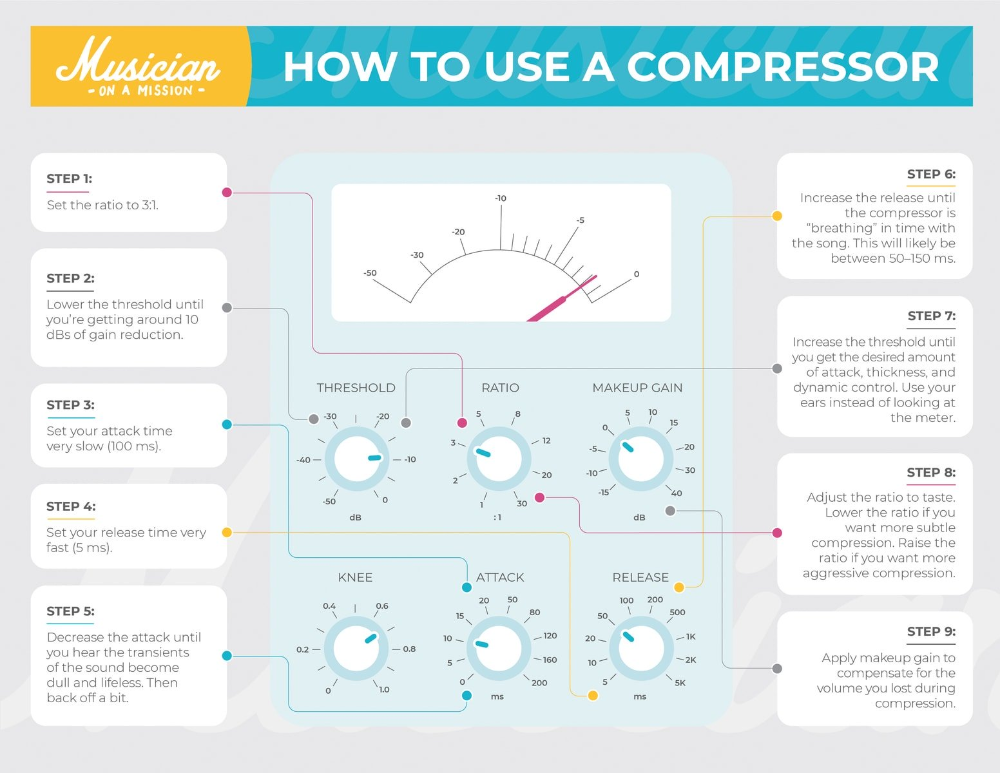 gov, properly inflating your tires can save you a lot of money. This is because under-inflated tires reduce gas mileage.
gov, properly inflating your tires can save you a lot of money. This is because under-inflated tires reduce gas mileage.
" Under-inflated tires can reduce gas consumption by approximately 0.2% for every 1 psi drop in the average pressure of all tires. Properly inflated tires are safer and last longer . "
Keeping your tires at the right psi level also prolongs tire life. When tires are under or over-inflated, unnecessary stress is placed on them, and therefore their life is negatively affected. In addition, under-inflated tires more often lead to flats
A quick and easy way to check and inflate your tires to the correct level will not only save you money on mileage and extend the life of your tires, but it can also keep you safe.0003
Although you can inflate your car tires with any size air compressor, the best car tire air compressor is powerful enough to be quick and convenient. After all, if you need to inflate a set of flat tires, you won't want to spend an hour or more while your little electric air compressor pumps air into the tires.
In general, an air compressor that can produce at least 1-2 cubic feet per minute (CFM) should be used to inflate tires. CFM is a measurement of the volume of air that is moved by the compressor. Many solutions, such as a compressor powered by an electric cigarette lighter, produce much less than 1 cu. Feet per minute and are generally only good for emergency inflation when no other options are available.
The most efficient car air compressor works with a tank that stores compressed air. A powerful unit with a suitably sized tank will continuously pump air at high pressure. It will quickly inflate car tires, bicycle tires and even truck tires.
Finding the best tire inflator really depends on your individual needs, but these are two of our favorites. One of the best things about each of these compressors is that they are both powerful enough to do more than inflate tires. Each of them represents a separate segment of the market.
The Porter PCFP02003 cable is suitable for cars, light trucks, SUVs, bicycles and small DIY projects. You can read our full review of this air compressor HERE.
Although capable of a variety of air tool related tasks, it is particularly impressive when it comes to tire inflation. Unlike some small compressors, the Porter cable is able to run almost continuously when tasked with inflating car tires. This is aided by a 3.5 liter tank in size 2.0 and CFM.
You will never need to wait for the compressor to turn on and re-air when topping up tires. However, if you are inflating full flats, you can wait a few minutes between each tire while the tank re-pressurizes. When it comes to bike tires, motorcycle tires, inflatables and water toys, Porter cable does a phenomenal job.
Our second favorite tire inflator is the DeWalt D55140. It's more compact than a Porter cable and perfect for tire inflation, but it will struggle with larger jobs.
If you don't need the flexibility to work with demanding air tools, DeWalt's D55140 is a great choice. When it comes to tire inflation, it works well with an airflow of just under 1cc. Feet per minute, and a small 1-gallon tank gives it a bit more running power. While the smaller tank requires the compressor to run continuously while the tires are inflated, it still needs to keep running and you don't have to wait for the compressor to re-pressurize.
When it comes to tire inflation, it works well with an airflow of just under 1cc. Feet per minute, and a small 1-gallon tank gives it a bit more running power. While the smaller tank requires the compressor to run continuously while the tires are inflated, it still needs to keep running and you don't have to wait for the compressor to re-pressurize.
Probably the biggest selling point for the D55140 is its portability. This is one of the most portable tank air compressors on the market. Weighing just 24 kilograms, it can be easily carried from job to job, and its streamlined design means it can fit snugly on a shelf or even tucked behind the seat of your truck.
The DeWalt D55140 is extremely quiet at just 69 decibels and is the perfect companion on the road. It would be nice to sit in a vehicle, truck or even an RV. Needless to say, just like the Porter cable, this air compressor packs enough power to pump up bike tires, motorcycle tires, or anything else around the house.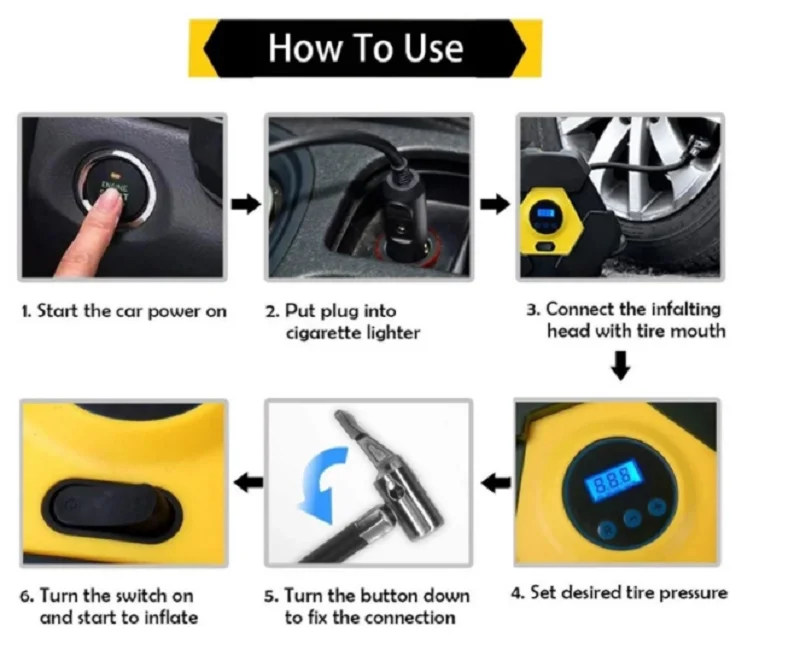
As discussed above, an inexpensive alternative to larger air compressors is a small portable 12V air compressor. This segment of air compressors is not only for inflating tires, but also for inflating air toys, sports balls, etc.
These smaller compressors allow you to connect them to power tools such as rattles, paint sprayers and nail guns, but however, they still give you the ability to navigate and mark that quick job off your list. The smaller tanks are also designed to cycle faster so you can work continuously without having to wait for the tank to fill up.
The Viair 00088 88P Portable Air Compressor is powered by a car battery and thanks to its powerful motor it can achieve a maximum working pressure of 120 psi. Which is quite impressive for such a small air compressor. This is a great option if you need a small, portable air compressor for refilling tires and balloons.
Viair 00088 has more than enough power to fill passenger car, light truck, SUV and motorcycle tires. It can handle any 33 inch tire or less. It's also one of several portable air compressors that come with alligator clips that attach directly to your car's battery. This eliminates any problems with the cigarette lighter shorting out or whether there is enough juice in your lighter.
It can handle any 33 inch tire or less. It's also one of several portable air compressors that come with alligator clips that attach directly to your car's battery. This eliminates any problems with the cigarette lighter shorting out or whether there is enough juice in your lighter.
The ability to connect directly to the car battery also means you don't need an extension cord or outlet. Not to mention the 10ft power cord and 16ft air hose, making the process of inflating your tires more convenient.
Measuring 11 inches and weighing just 4-1/2 pounds, the Viair is one of the most compact and portable models on the market today and comes with a one year warranty.
EPAuto 12V DC Portable Air Compressor Pump is not as powerful as the Viair 00088, but it still performs well, and best of all, it's available at a price that every budget can handle.
Designed with an easy to read display and LED light, the EPAuto Air Compressor also contains a needle for inflating sports balls and a short/long cone for inflating inflatable kayaks and pool accessories. It can handle car, bicycle, sedan and midsize SUV tires.
It can handle car, bicycle, sedan and midsize SUV tires.
EPAuto has a built-in overheating protection to prevent the air compressor from being overloaded and you can plug it directly into the cigarette lighter. Since it is equipped with an automatic switch, you will never have to worry about inflating your tires.
The Kensun AC/DC Swift Performance Portable Air Compressor may be one of the most user-friendly pumps on the market today. This 12V air compressor can be powered in two different ways, making it convenient for both car and home use.
Plug the Kensun AC/DC Swift into your car's cigarette lighter and it works just like any other inflator on the market, but pull out the extension cord and it plugs directly into a standard outlet, making it much easier to inflate bike tires and sports competitions. equipment.
Equipped with dual all-metal motors for quick and easy pumping and a large bright gauge that measures up to 100 psi, this is a great portable air compressor that can handle car, motorcycle and bicycle tires and all other inflatables like pool toys , sports equipment and kayaks.
There are two types of tire inflation. One style is associated with an air compressor. They provide either a digital or analog reading of tire pressure. In addition, they also control the air flow.
Another type of tire is a small air compressor designed specifically for inflating tires. This type, like 12 volt compressors, is not designed to provide high power. They can take on tires and other light projects, but that's about it. The big difference between a tire inflator and a 12V compressor is that a tire inflator does not have an air tank, so it will run continuously.
When buying tire inflation, you should consider the following:
LCD Screen - The LCD screen is a good feature because it displays the pressure. Other more traditional models use a dial and needle setting that can be harder to read.
Auto shut off - One of the key features to look for is auto shut off. This feature can be set to your desired psi and you can walk away knowing that once your desired pressure is reached, the compressor will automatically shut off.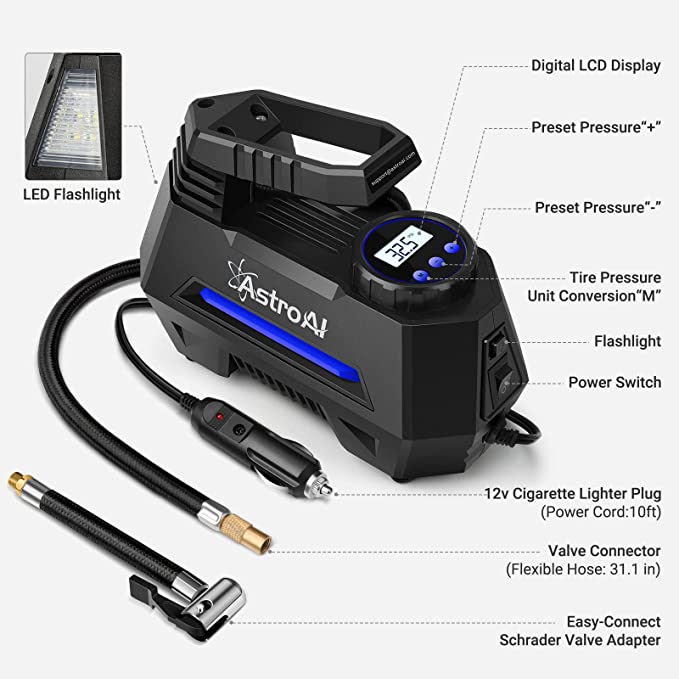
Cigarette Lighter Charging Cord - When you're on the road and need to pump up your tires, a cigarette lighter charging cord can save you the hassle of calling for help or finding the nearest gas station.
Built-in light - In an emergency at night this can be especially tricky, so inflating tires with built-in lights can be a huge help. You will be able to see both the tire and the work area without fiddling with a flashlight.
Below you will find three of our most popular tire pumps:
EPAuto Heavy Duty 120 psi tire inflator, probably the best inflator for the money. This is a three-in-one tool that combines a gun for refueling, air cartridge and pressure gauge. This is great if you're on a tight budget and don't want to spend a lot of money.
With tires ranging from 0 to 120 and a large, accurate, easy to read display, this tire inflator is suitable for a wide range of inflation tasks.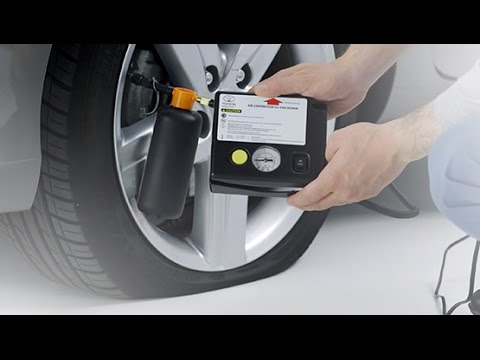 Despite the low price, the device performs well and doesn't feel like you're using a budget tool. However, there are quite a few plastic parts, so you need to be careful when handling and storing.
Despite the low price, the device performs well and doesn't feel like you're using a budget tool. However, there are quite a few plastic parts, so you need to be careful when handling and storing.
Best Portable Inflatable Tires (Review and Buy Guide) in 2020
Inflatable Tires are pumps that use compressed air to inflate truck and car tires. Compressed air allows you to get the job done quickly and efficiently. The best portable inflatable tires can fit into the trunk or cargo area of your car so you can easily reach it during a road accident. If you are looking for the best portable tire pump on the market, check out our reviews below.
 You know it will work compared to some gas stations that have pumps that don't work and cost a little money.
You know it will work compared to some gas stations that have pumps that don't work and cost a little money. The best inflatable tires for cars and the best inflatable tires for trucks can be used on the road. During an emergency, you can power some models by connecting them to the cigarette lighter socket / 12 volt power supply in the car. This is especially useful if your car or truck has 12V DC outlets in more than one location.
The best cordless inflator is usually powered by a lithium-ion battery. They are generally easy to use and very portable. These pumps are portable and provide enough power. It is very important to keep the battery charged or else you could be stuck in a flat tire.
These tire inflators attach directly to the battery for maximum power so you don't need to keep your car running. However, the tire pump can discharge the autonomous battery charge in about 20 minutes.
Kensun, Inc., based in the USA, was founded in 2009. While their most popular products are car headlights such as HID bulbs and xenon bulbs, the company also produces tire inflatables such as Kensun Tire Inflator AC/DC Portable Air Compressor Pump.
VIAIR Corporation, based in Irvine, California, was founded in 1998 and manufactures fractional power DC oil-free air compressors and air accessories for on-road, off-highway and industrial markets. One of the high end tire compressors is the Viair 40047 400P-RV Portable Auto Compressor Kit.
One of the high end tire compressors is the Viair 40047 400P-RV Portable Auto Compressor Kit.
Helteko is a new company founded in 2017 by S.G. Royals. It manufactures automotive consumer products, including vacuum cleaners, car seat protectors, and digital air compressors. One popular product is the Helteko 150PSI 12V Digital Tire Inflator.
JACO is an automotive accessories company that started as a two-person business in 1983. The original warehouse and office remain in Crystal Lake, Illinois, where the company also conducts quality testing. They have another test plant in Evergreen, Colorado. One of the best products is the JACO FlowPro tire pump with pressure gauge.

The best digital inflatable tires will display the inflated pressure on the gauges. arrow pointers. The digital display will give you more accurate readings. Another added benefit is that you will be able to read it in low light if the screen is backlit.
The auto shutoff feature allows you to set the desired PSI value and the vehicle's tire inflation will continue until it reaches the desired pressure. This is a practical feature because inflating the tires will not over-inflate the tire. You can walk away from the device as it does its job and not worry about busting a tire.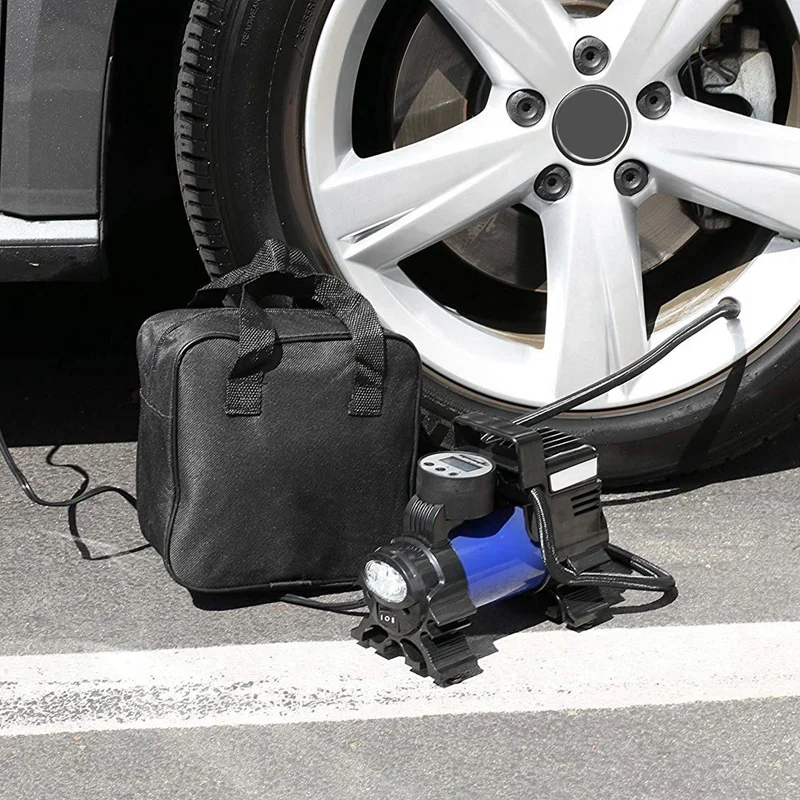
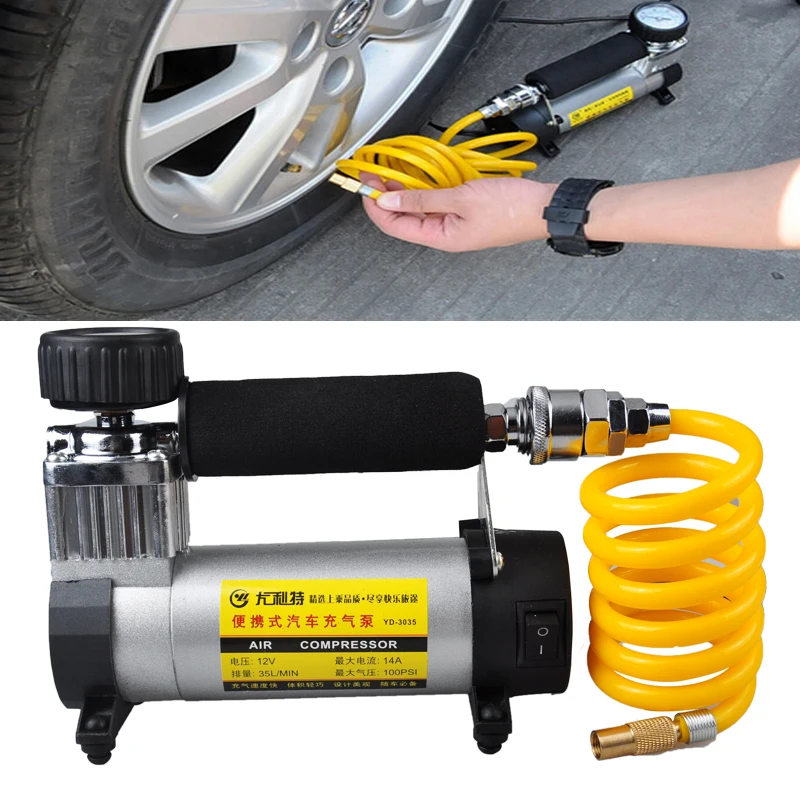
 Leaning into the ground to fill a tire with an air pump rumbling next to you can be distracting and annoying if it's exceptionally loud. Be sure to choose a product that won't bother your ears.
Leaning into the ground to fill a tire with an air pump rumbling next to you can be distracting and annoying if it's exceptionally loud. Be sure to choose a product that won't bother your ears.  This can lead to dry rot on the rubber on the sidewall of the tire. This damage will eventually lead to tire failure, which can be dangerous.
This can lead to dry rot on the rubber on the sidewall of the tire. This damage will eventually lead to tire failure, which can be dangerous. A: PSI stands for pounds per square inch and is used to measure tire pressure. For example, 300 psi means 300 psi. In air compressors, the PSI sensor is the equivalent of the fuel sensor.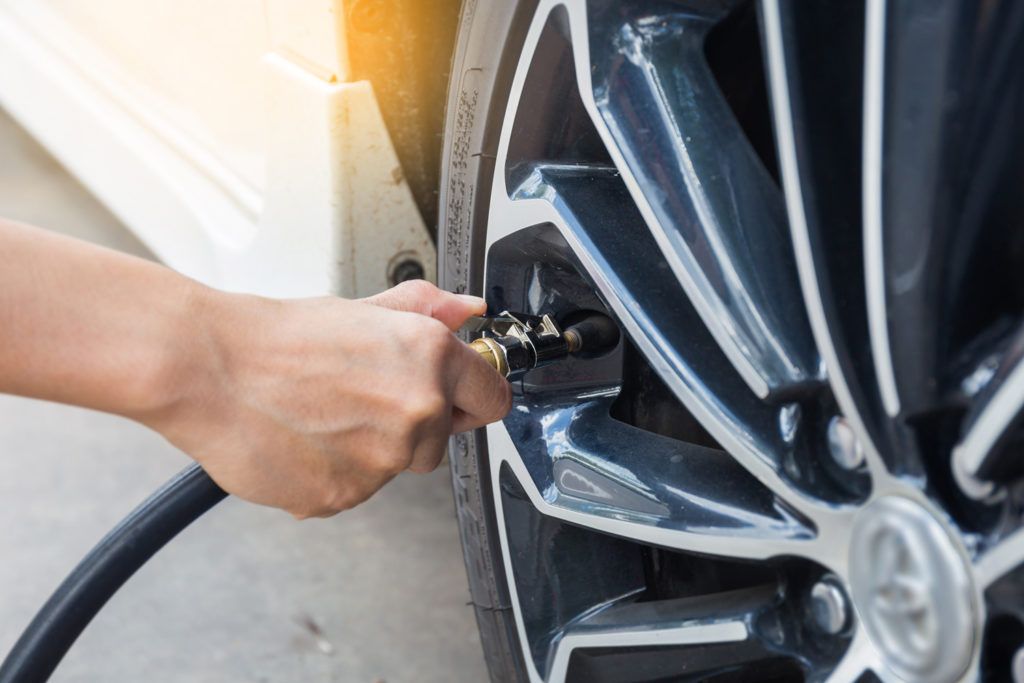
A: Look at the sidewall of the tire. Tire dealerships also have charts to provide you with PSI information considering factors such as the weight of your car or truck.
A: Remove the valve stem caps and press a pressure gauge into the valve stem. Check the pressure gauge to determine the air pressure in the tires. Replace the valve stem caps.
A: Remove the valve stem caps. Slide the compressor hose fitting onto the valve stem and check the pressure gauge. Fill tires to recommended pressure (best done when tires are cold). Install the valve stem caps.
Our pick for the best portable tire inflator is the Avid Power Tire Inflator Air Compressor. It's fast and efficient and includes an auto-off feature.
For something even more value, consider the Ryobi P737 18V ONE+ portable tire blower.